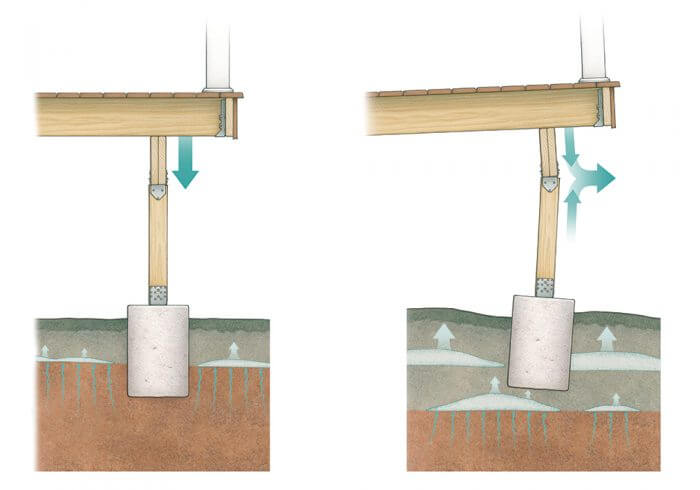The cold winter months of the Canadian climate results in the upper layer of the ground freezing for several months out of the year. The depth of frost penetration into the ground depends on the local climate and soil conditions but can reach up to several metres. Freezing ground frequently results in the soil expanding, which can cause structures above or adjacent to be raised or displaced.
Frost heave is a natural occurrence, which develops as the moisture within the soil freezes and expands. Ice continues to develop in the soil pores as the temperature progressively decreases or during prolonged periods of cold temperatures. For frost heave to occur you must have freezing temperatures, water, and a frost-susceptible soil. Frost-susceptible soils are those with pore sizes between the soil particles that promote capillary flow and retain moisture; they commonly include clays, silts, and loams.
Heaving in Structures
Frost heave can wreak havoc on concrete driveways, sidewalks, and patios around your home. As the soil beneath the concrete freezes and expands, the resulting upward force or pressure beneath the concrete can cause it to rise. The pressure beneath the concrete may not be distributed equally and stress cracks may develop. As the frost within the soil thaws and melts, the concrete can settle back towards its original position; however, it may remain raised if uneven base material develops beneath the concrete or if sufficient sized cracks develop. This cycle repeats itself every year and can continue to deteriorate the concrete.
 Straight shaft concrete piles are commonly used to support above ground decks or sunrooms and are typically installed to a depth below the frost line; however, if they aren’t, frost in the ground can result in piles being lifted or raised, resulting in damage to the structure above as well as the piles. As the soil freezes around the piles, it adheres to the steel or concrete developing a substantial adfreeze bond. As the frozen ground expands upward, the adfreeze bond to the pile results in an upwards force on the pile, known as an adfreeze force. If the adfreeze force is greater than the resistance from the pile length below the frost line combined with the load of the structure above, the pile can be raised out of the ground. This phenomenon is known as frost jacking and can repeat itself, raising the pile more with each freeze thaw cycle. Once the pile has been lifted from its original position the gap formed beneath the pile may be filled with some surrounding soil, making it unable settle back to its original position and possibly requiring repairs or replacement.
Straight shaft concrete piles are commonly used to support above ground decks or sunrooms and are typically installed to a depth below the frost line; however, if they aren’t, frost in the ground can result in piles being lifted or raised, resulting in damage to the structure above as well as the piles. As the soil freezes around the piles, it adheres to the steel or concrete developing a substantial adfreeze bond. As the frozen ground expands upward, the adfreeze bond to the pile results in an upwards force on the pile, known as an adfreeze force. If the adfreeze force is greater than the resistance from the pile length below the frost line combined with the load of the structure above, the pile can be raised out of the ground. This phenomenon is known as frost jacking and can repeat itself, raising the pile more with each freeze thaw cycle. Once the pile has been lifted from its original position the gap formed beneath the pile may be filled with some surrounding soil, making it unable settle back to its original position and possibly requiring repairs or replacement.
Prevention
You may not be able to prevent frost heave from occurring; however, a few things can be done to mitigate the adverse effects to a property:
- Landscaping should slope away from foundations, driveways, sidewalks, patios and exterior planter boxes. This minimizes the amount of moisture accumulating in the soil beneath structures from rain or snowmelt that is able to freeze resulting in frost heave.
- Cracks in concrete driveways sidewalks, and patios should be sealed to prevent moisture entering and freezing, which can result in additional damage to the concrete and additional moisture in the soil beneath the concrete.
- Straight shaft piles supporting a structure must be installed with enough pile length below the frost line to resist the uplift forces caused by adfreezing, preventing the pile from being jacked out of the ground.
Heaving can be responsible for extensive structural damage and, if left undiagnosed, can result in costly repairs year after year. Our structural experts can investigate suspected heaving damage, determine the cause and provide recommendations that will last well beyond the next freeze/thaw cycle. For more information, or to find out how we can help with your claim, call us at 877 686-0240
